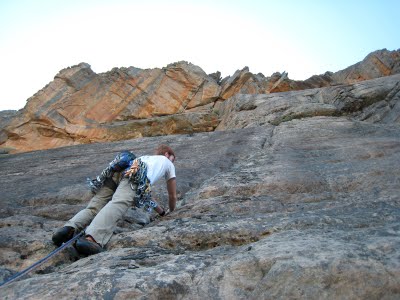For Easter I had planned to go to Chamonix, France with my friend Anders Strange Nielsen to climb ice or rock routes. However, we were met by lots of fresh snow. We had driven all night and were discussing our options over breakfast and made the logical decision to go off-piste skiing on the Grand Mulets. We had a great day as the morning snow was awesome powder, but later in the day the snow warmed up and got less interesting.
 |
| Off-piste skiing on the Grand Mulets, Chamonix, France. |
Quite a few Danish climbers had also chosen Chamonix for their Easter destination, and we had a great dinner with them in the evening. The weather forecast was looking like more snow and not exactly good climbing weather, so back at the hotel we decided to head South to Gorge du Verdon to go rock climbing in (hopefully) better weather.
The next morning we thus headed South and made a pit stop in beautiful Sisteron to sportsclimb for a few hours before heading further South. The rock is classic limestone and nothing special, but the views are stunning with the River Durance and the ancient Sisteron Cathetral in the background.
 |
| The beautiful Sisteron crag with the River Durance and the ancient Sisteron Cathetral in the background. |
Late in the evening we arrived in Palud-du-Verdon where it turned out that we were lucky to get a room without a reservation. The climbing in the Gorge du Verdon is very special as you rappel up to 300 meters in the gorge and then (hope to) climb up again. It is thus recommended not to test your climbing limit on your first day, and we thus started out by climbing in a single pitch crag
Valaute which gave a good introduction to the rock. In addition it can be a challenge to find the correct rappel for your route on the big walls. For some routes the name has been written on the rock above whereas it is not so obvious for other routes. We thus also spent some time on the first climbing day to scout the correct rappel for our "big" route while taking in the beautiful views:
 |
| Beautiful early morning views of the canyon. |
 |
| Looking for the correct rappel for our route Les Dalles Gris. Note the climber in red for perspective. |
Initially we wanted to climb the ultra-classic route
La Demande (6a, 320 m), which is one of the few routes going all the way from the valley to the rim (most routes start from ledges on the wall). However, the next morning I felt somewhat sick and not really up for such a long route and we thus changed our objective to the shorter and slightly easier route
Les Dalles Gris (5c, 150), which however is also an ultra-classic route. This turned out to be a wise choice as I got quite sick the following days from a viral lung infection!
 |
| Anders Strange standing on the ledge and pulling the ropes. |
We rappelled the route to a ledge halfway down the wall, pulled the ropes and hoped we could climb up again! It turned out to be easy and pleasant climbing and the exposure was not as bad as I had feared. It was thus a very nice route to start out with and I have certainly been inspired to come back and climb on the big walls again now that I know it is manageable!
 |
| Anders Strange following on the last pitch to the rim. Great exposure! |
Labels: climbing












































 blog updates
blog updates